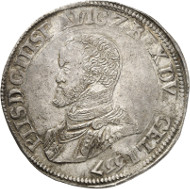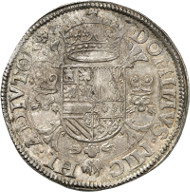Human faces, part 39: The price of power
courtesy of the MoneyMuseum, Zurich
translated by Teresa Teklic
Why was the human head the motif on coins for centuries, no, for millennia? And why did that change in the last 200 years? Ursula Kampmann is looking for answers to these questions in her book “Menschengesichter” (“Human faces”), from which the texts in this series are taken.
Philip II of Spain (1556-1598), as Lord of Gelderland. Thaler, 1557. Armour-clad bust of Philip to the left. Rev. Crowned coat of arms, Order of the Golden Fleece below, Burgundian andirons to the left and right. © MoneyMuseum, Zurich.
In 1545, large silver resources were discovered in the Spanish colonies, near Potosí in today’s Bolivia and near Zacatecas in Mexico. This means that, beginning in the 1560s, vast amounts of silver were shipped to Spain from the colonies.
Spain imported 303 tons of silver between 1551 and 1560, and, within the next ten years, 943 tons, almost three times as much. Between 1571 and 1580, silver mining was at its highest, with 1119 tons of the precious raw material being shipped across the ocean.
With that amount of silver in its treasury, Spain should have become Europe’s leading economic nation. But the situation was just like this Venetian ambassador expressed it in this apt metaphor: “About the treasure that is brought to Spain from the West Indies the Spaniards say […] that it benefits them just as much as rain hitting a rooftop. If it rains heavily, the water will run down so that the first ones whom it hits cannot profit from it.”
Antonis Mor, portrait of King Philip II of Spain, 1557. Source: Wikicommons.
Philip II, King of Spain, did not care for business and trade. He considered it his royal mission to convert the whole world to the Catholic faith.
On 28 August 1567 for instance, the Duke of Alba, on the King’s behest, marched into Flanders. He was charged with putting down the revolts of the Iconoclastic Fury and in Brabant. For this mission, Alba had been given generous funds by Philip. His soldiers were followed by a large number of wagons loaded with silver coins.
The lines of wagons kept rolling to the front more and more often: not just to the Netherlands, but also to Italy, France, the German Empire and Portugal. Moreover, Philip wanted to defeat the Turks and subject England as well – and those plans were expensive. And so the wagons with silver kept rolling on and on – but they still weren’t rolling often enough.
Even the large amounts of silver imported from the Americas were not enough to cover the expense of the king’s great military ambitions. More than once, Philip II was forced to declare state bankruptcy and more than once, this cost Spain an otherwise sure victory. In 1575 for instance, it would not have taken the Spaniards much more to reduce William of Orange and the Netherlands to a footnote in the book of history. Unfortunately, Philip declared state bankruptcy on 1 September and the Spanish soldiers, already without pay for months, put down their weapons in the war against the Netherlands and instead looted the allied but richer cities in Flanders and Brabant.
Neither Philip, nor any of his successors to the Spanish throne were ever to succeed in conciliating their ambitions for world domination with the nation’s financial resources.
The next episode is dedicated to Elisabeth I and the industrious freebooters who regularly captured new treasures to fill their queen’s treasury.
You can find all episodes in the series here.
A German edition of the book “Menschengesichter” is available in print and as ebook on the site of the Conzett Verlag.










